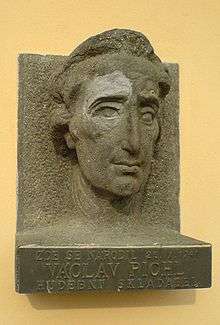Wenzel Pichl

Václav Pichl (25 September 1741 – 23 January 1805; known in German as Wenzel Pichl) was a classical Czech composer of the 18th Century. He was also a violinist, music director and writer.
Pichl was born at Bechyně, Bohemia. His first musical training was at Bechyne with the cantor Jan Pokorný. He served as a singer between the years 1752-1758 at the Jesuit college at Březnice. In Prague, he was a violinist at the Jesuit seminary of Saint Wenceslaus and his studies while at the university were philosophy, theology and law.
He was appointed to the post of first violinist of the Týn Church in 1762 and studied counterpoint with the organist J. N. Seger. In 1765 he was engaged by the composer Karl Ditters von Dittersdorf as a violinist for the private orchestra of Bishop Adam Patachich at Nagyvarad (now Oradea, Romania). The orchestra was dissolved in 1769 and Pichl became the music director for Count Ludwig Hartig in Prague.
In about 1770 he became first violinist of the Vienna court theatre and on the recommendation of the Empress Maria Theresa, he became music director for the Austrian governor of Lombardy at Milan, Archduke Ferdinand d'Este. Pichl went to Italy in 1777 and remained there until 1796 when the French invaded Lombardy, he then returned to Vienna, where he stayed in the service of the archduke until his death (apart from a brief visit to Prague in 1802).
Wenzel Pichl died at Vienna, Austria, on 23 January 1805, as the result of a stroke while playing a violin concerto at the Palais Lobkowitz. He was 63 years old.
Selected works
- Six symphonies, opus 1 (two oboes, two clarinets, two horns, drums, strings. about 1778. "SEI SINFONIE A PIÙ STROMENTI. Dedicate A SUA ALTEZZA REALE IL SERENISSIMO ARCIDUCA FERDINANTO Principe Reale d'Ungeria e Boemia ... Da WENCESLAO PICHL. in attuale Servizio dell'Istessa Altezza Reale. OPERA PRIMA") [1][2]
- Six string quartets, opus 2 (in A, C, F major, E minor, D major, and B♭. about 1779.) [1]
- Three violin concertos, opus 3 (in D, G and B♭. 1779.) [1]
- Six trios concertans, opus 7 (in C, F, B♭, E♭, A and D. 1783.) The front page of this work (IMSLP) states that he was a pupil of M. Haydn [1]
- Three symphonies, opus 8 (in C, E♭ and D. 1784.) [1]
- Six duos for violin and viola, opus 10 (in C, G, D, B♭, F, E♭. 1784.) [1]
- Three quartets for flute, violin, viola, and violoncello, op. 12 (1787) [2]
- Three string quartets, opus 13 (in A, B♭ and E♭. 1788.) [1]
- Three symphonies, opus 15 (in D, B♭ and C. 1790.) [1]
- Three duos, for violin and cello, opus 16 (Amadeus Edition edited by Bernhard Pauler, published in 2002)
- Twelve caprices for solo violin, opus 19 [2]
- Three sonatas for solo violin with accompaniment of violin or viola, opus 23 [2]
- Symphonies for orchestra opus 24 [1]
- Sei fughe con un preludio fugato : per un violino solo [2] (may be opus 41 [1])
- Etude for the violin in the form of twelve caprices, opus 46 (about 1801) [2]
- Koncert for String Bass and Orchestra in C major
External links
- 1 2 3 4 5 6 7 8 9 10 "National Library of the Netherlands". Retrieved 2007-10-08.
- 1 2 3 4 5 6 "Bayern Gateway OPAC". Retrieved 2007-10-08.